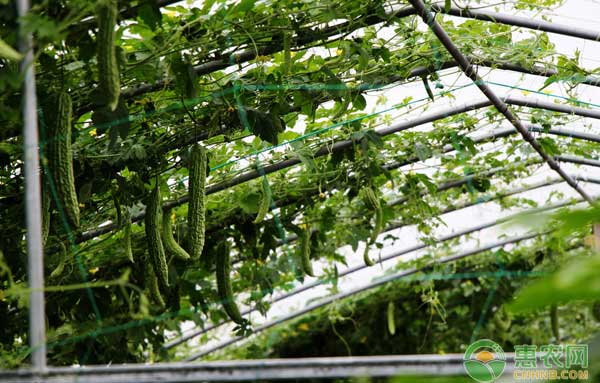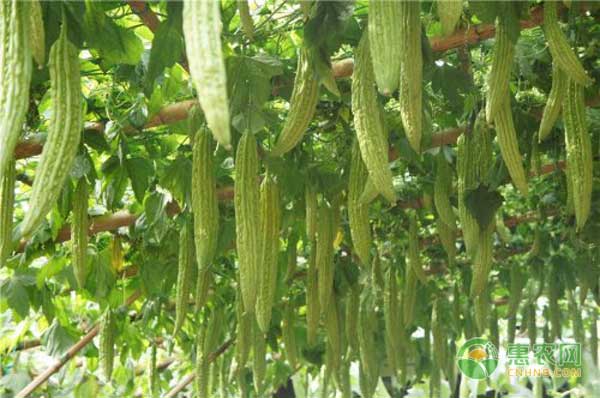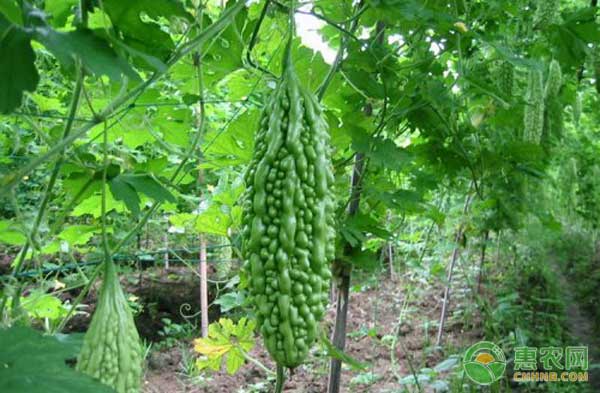Bitter gourd is rich in vitamin C, protein, fat, etc., and is rich in nutrients. Although bitter gourd is bitter, it is also one of the favorite vegetables. Bitter gourd is warm and cold, and the northern region can provide the annual supply of bitter gourd through the cultivation of protected land. Here is a brief introduction to the production management techniques of bitter gourd in greenhouse.

Germination
In the production, it is recommended to use warm water scalding and temperature-changing germination methods, which can not only improve the germination rate of seeds, but also achieve the purpose of seed disinfection. Methods as below:
(1) Soaking seeds: It should be carried out 5 to 6 days before sowing. There are five common methods.
1 soaked in water. Different soaking time had certain influence on the germination of bitter gourd seeds. The seed germination rate was the highest in 12 hours of soaking seeds; the germination power showed a downward trend in more than 12 hours.
2 warm water soaking seeds. Put the bitter gourd seeds into the gauze bag and wash them with water. When washing, gently wipe the seeds and remove the water-impermeable material. Soak the washed seeds in warm water at about 55 °C for 10 minutes and stir constantly, then add cold water. The water temperature is reduced to 25 ° C ~ 30 ° C, soaked for more than 12 hours to remove the seeds, wrapped in a damp cloth into the box, covered with a damp cloth placed at a temperature of about 30 ° C and a sufficient humidity for germination.
3 gibberellin soaking seeds. Soaking seeds with gibberellin can significantly increase the germination potential and germination rate of bitter gourd seeds, and the treatment effect at 40 mg/kg is better.
4 Brassinolide (BR) soaked seeds. The germination potential and germination rate of 1:1500 times BR soaking treatment were significantly higher than that of common soaking, which had obvious promoting effect on the germination of bitter gourd seeds.
5 hydrogen peroxide (hydrogen peroxide) soaking seeds. 50% hydrogen peroxide was soaked for 3 hours and then washed. The germination rate and germination rate of hydrogen peroxide soaking were increased by 24.0% and 28.1%, respectively.
(2) Variable temperature germination. The bitter gourd seed shell is thick and hard, and the conventional constant temperature germination shows slow bud and low germination rate. Switching to the bag and changing the temperature and germination can make the seed germination fast and the germination rate is high. The specific method is to dry the treated seeds first, pry the seed tip into the small gauze bag with pliers, and then put it into the prepared plastic bag to seal the bag mouth. Then place the plastic bag at the corresponding heat source, treat it at 33~35°C for 10~12 hours, and at 28~30°C for 12~14 hours. Then combine the temperature adjustment to loosen the mouth of the bag for one time. Pay attention to this process: ensure that the volume of the plastic bag is 20 to 30 times the volume of the seed so that there is sufficient air (oxygen) in the bag. Keep the plastic bag sealed to keep the small dew on the inner wall of the bag. If the surface of the seed has more mucus, it should be rinsed and dried in time to facilitate ventilation. Generally, the germination rate can reach 80.9% within 3 days, and almost all sprouts within 4 days, which is 42% higher than that of the conventional method.
Sowing time
(1) Sowing date selection. The number of days from bitter melon to harvesting under suitable conditions is 90-100 days for early-maturing varieties, 105 days for medium-maturing varieties, and 120 days for late-maturing varieties.
(2) The main points that should be mastered by nursery. The nursery period is in the high temperature season from August to September. High temperature seedlings are often exposed to pests such as viral diseases, whitefly, Fuxi and sassafras. Therefore, the key to breeding seedlings is to avoid strong light from illuminating the seedbed, avoiding rainwater washing the seedbed and preventing water accumulation in the seedbed. It is necessary to prevent viral vectors such as whitefly and aphids from entering the nursery bed. Specifically, the following points should be mastered:
1 Use a sunshade net to shade the seedbed before and after noon on sunny days to avoid strong light from illuminating the seedbed. Rainy days should be used to cover the seedbed with plastic film. Do not let rainwater enter the nursery bed.
3 It is necessary to use a pest control net to seal the seedbed to prevent whitefly, mites and the like from entering the nursery bed.
4 Grafting seedlings were adopted to alleviate the occurrence of soil-borne diseases, and the rootstock varieties were selected to go to South Black Pumpkin.
5 It is necessary to spray drugs regularly to prevent diseases. Generally, the medicine is sprayed once a week from the emergence of seedlings, and carbendazim, anti-virus, metalaxyl and virus A are alternately sprayed. In the true leaf stage of bitter gourd, 20~40 mg/kg gibberellin was sprayed on the leaf surface, so that the first male flower node of bitter gourd increased, the first female flower node decreased, and the total number of female flowers and the ratio of female and male flowers were rise.

Application of gibberellin on bitter gourd
The flower of bitter gourd is monoecious and the flower bud differentiates early. Gibberellin has an effect on the sex differentiation of bitter gourd. The specific use effects and methods are as follows:
(1) Use effect: Gibberellin has an effect on the sex differentiation of bitter gourd, and low concentration of gibberellin has a significant effect on the female. Spraying gibberellin can increase the first male flower node of bitter gourd, and the first female flower node will decrease. The total number of female flowers and the ratio of female and male flowers will increase. At the same time, gibberellin treatment can increase the rate of bitter gourd and the weight of single melon, thereby increasing the yield per plant.
(2) Usage: In the true leaf stage of bitter melon, spray the leaves with 20-40 mg/kg gibberellin solution.
(3) Note: The concentration of gibberellin used is too high to promote the female effect and the plants are chlorotic or even dead, causing the fruit to be deformed. Pure gibberellin can be dissolved first with alcohol or high concentration of shochu, and then the water should be at the required concentration. Avoid hot water above 50 °C. The solution should be used immediately for a long time.
Field management of bitter gourd
The management of bitter gourd in the vine period is to control the growth rate of stems and promote the rapid growth of roots. Due to the strong branching power of bitter gourd, each leaf axil will germinate lateral vines when conditions are suitable, and the plant growth should be adjusted to achieve early maturity and high yield. To this end, we should do the following management techniques.
(1) cultivating loose soil: After the bitter gourd is planted, due to low ground temperature and slow root development, it is necessary to timely cultivate and raise soil temperature, increase soil permeability and promote root development.
(2) Hangers and vines: When bitter gourd begins to smash, it is necessary to hang the vines and pruning in time. Due to the strong branching power of bitter gourd, especially when the outside temperature is low, the branches are more, which affects the growth of the main vine. When the greenhouse is cultivated, it is necessary to fight in time. Generally, the side vines under 15 leaves are all removed, and the side vines after 15 leaves can leave one. Pay attention to the reasonable introduction of the vines so that they are evenly distributed.
(3) Fertilizer and water control: The bitter gourd is generally required to control water for a living. In order to prevent the excessive soil moisture, the plant grows at the time of planting, and the foot is not watered. If the soil is large in sand and poor in water retention, it is necessary to properly pour small water in the presence of drought. Under normal circumstances, it is not advisable to apply fertilizer. In this period, foliar fertilizer is added to supplement nutrition.
(4) Strict prevention of diseases: White rot disease is a serious disease that causes the whole plant of bitter gourd to wither, especially in the autumn and winter 茬 茬 伸 , , , , , , , , , , , , , , , , , , , , , , , , , , , , , , , , , , , , often bring devastating disasters to bitter melon production. Therefore, the prevention of bitter gourd chalk can be sprayed with Jinggangmycin water or 20% methyl chlorophosphorus emulsifiable concentrate, or 50% Tianan water 600 times solution, 0.5 liter per spray liquid.
Field management of bitter gourd flowering
Warm light regulation
(1) Illumination: bitter gourd is light, heat-resistant, especially the result of flowering is more strict with the requirements of illumination. In the case of continuous rainy weather, the yield of melons will be significantly reduced. The main light management measures for greenhouse cultivation are early exposure and late cover to extend the illumination time; often cleaning and scrubbing the membrane to allow more light and better access to the greenhouse to enhance the photosynthetic capacity of the plant. Pay attention to the rainy weather, and also open the grass to transmit light. It is also very important to use the astigmatism of the cloudy sky to compensate the light of the plant. In the rainy weather, you can't just ignore the insulation and ignore the light management.
(2) Temperature: The flowering result period requires suitable temperature conditions, and the long-term low temperature may cause falling flowers, fruit drop and fruit malformation. The optimum temperature in this period is 25 °C ~ 28 °C, generally 28 °C during daytime high temperature, not less than 13 °C ~ 15 °C at night, relatively increase the temperature to improve the speed of manufacturing nutrition and transport nutrients to various parts, and promote the absorption of nutrients Can increase production. When the greenhouse is cultivated in the off-season, the flowering result period should be heated if it encounters a strong cold and cold current. When the temperature in the shed is lower than 8 °C, a simple heating method should be used to maintain the minimum temperature required by the bitter melon in the shed to prevent freezing damage. Or cold damage.
Water and fertilizer management
The source of bitter gourd nutrition depends on mineral nutrition in the soil and assimilation of photosynthesis in plants. The management focus of this period is to ensure the smooth flow of nutrients and meet the requirements of bitter melon for nutritional indicators.
Water and fertilizer management is a key measure to supplement plant nutrition. According to the demand of water and fertilizer conditions in various stages of bitter gourd growth, timely provide suitable water and fertilizer for the growth of bitter gourd. The contradiction between flowering at the beginning of flowering and vegetative growth of plants is not obvious. During the full bloom period, the relative humidity of the air is required to temporarily control the watering. After pollination and fertilization, the fruit enters the development stage, which is a timely period for water and fertilizer requirements. When the greenhouse is cultivated and watered, it is not possible to flood the irrigation water. The number of watering should be increased. Each time the small water is used to meet the demand of water and fertilizer. Generally, watering should be combined with topdressing. In the result, the demand for nitrogen and potassium is large. Each time 667m2 is watered, 20kg of urea, 10kg of potassium sulfate or 30kg of ternary compound fertilizer are applied. As the yield increases, the amount of fertilizer applied should increase accordingly. This period should also be combined with foliar top dressing to supplement nutrition.
Plant adjustment
The growth of stems and vines in the fruiting stage of bitter gourd is still continuing. Plant adjustment can prevent the greenhouse from being closed and affect the light, reducing the nutrient consumption of the plants. Plant adjustment during the flowering period should be carried out in a comprehensive manner. There are three main tasks:
1 dozen old leaves. During the growth period, the lower old leaves are knocked out in time, and the leaves that are yellow, crisp, and excessively overlapped are destroyed by the sunny day. In addition, the old side vines that have been fruited are cut off in time. The diseased leaves should be cut to prevent the spread of the disease.
2 Falling Man: Put the light poles behind the old leaves on the ground. Generally, at noon, the vines tied to the upper part are untied to drop the whole vine, and the vines with leaves are returned to the middle and lower part of the space of the shed, and the upper part leaves space for the management of light, warming and peace.
3 promptly remove the new side vine growth point. Bitter gourd grows new side stalks during the growing and growing process. When 2 to 3 leaves are formed on the side vines, the growth points are removed in time to prevent the side vines from being too long.
Preserved fruit
There are three main ways to preserve the fruit in the low temperature period.
(1) Artificial pollination: The parthenocarpy rate of bitter gourd is higher, but pollination can increase the fruit setting rate and promote fruit development. Due to the low activity of small insects in the protected area, it is necessary to carry out artificial pollination. The male flowers in full bloom can be removed from 7 to 8 am to remove the corolla, and the anthers are applied to the stigma of the female flowers to increase the fruit setting rate. This is the main method for protecting the bitter melon and protecting the fruit.
(2) Bumblebee pollination: Bumblebee pollination can be used from April to November.
(3) Application of anti-fallin: Before 10:00 am, the stalk and stigma were coated with 20-30 mg/kg of the anti-fallin solution. The fruit setting rate with the anti-falling fruit is not as high as that of artificial pollination and Xiongfeng pollination. This method is only used in the absence of male flower pollen. For the production of green food bitter gourd, try not to use the method of preventing the fruit from falling.

Harvest at the right time
Bitter gourd is usually harvested about two weeks after flowering. The strips or knobs of the fruit are full and shiny, and the fruit top is lighter when it is lighter. Premature and late harvesting has a great impact on the quality and yield of bitter gourd.
The maturity of bitter gourd fruit has a certain relationship with nutrient consumption. The fruit that meets the maturity of the product has relatively little nutrient demand; it enters the stage of physiological maturity (the seed is full of growth). Because of the development of seeds, it needs to enrich and store a large amount of nutrients such as protein and fat. It takes 3 to 5 young melons to leave one old melon on the plant. Therefore, it is necessary to timely and timely harvest, and the melons that should be harvested should not be forgotten on the plants and harvest malformed and poorly-priced melons at any time to reduce nutrient consumption.
Bitter melon is one of the more popular vegetables on the market, and the planting benefits are still considerable. By listing in the winter and spring, you can avoid the peak period of bitter gourd, and increase the price and increase the planting efficiency. The above content is for reference only. If you want to know more about agricultural technology, please pay attention to us!
5 Lbs Xylitol Bag,Competitive Price Bulk Xylitol,Best Xylitol Sweetener Competitive,Sweetener Bulk Xylitol
Soar Biotech Co.,Ltd , https://www.xylitgum.com